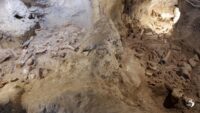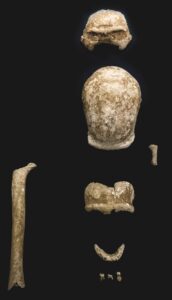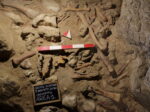 The remains of nine Neanderthals have been unearthed in the Guattari Cave near the seaside town of San Felice Circeo, 70 miles south of Rome. The cave’s entrance, blocked off by a rockslide that stopped human occupation of the site tens of thousands of years ago , was discovered by accident on February 24th, 1939. Inside were animal bones, the remains of hyena repasts, and in the last chamber the well-preserved cranium of a Neanderthal. The chamber would henceforth be dubbed the Antrum of Man.
The remains of nine Neanderthals have been unearthed in the Guattari Cave near the seaside town of San Felice Circeo, 70 miles south of Rome. The cave’s entrance, blocked off by a rockslide that stopped human occupation of the site tens of thousands of years ago , was discovered by accident on February 24th, 1939. Inside were animal bones, the remains of hyena repasts, and in the last chamber the well-preserved cranium of a Neanderthal. The chamber would henceforth be dubbed the Antrum of Man.
Even with a large hole in the temple, it was one the best-preserved Neanderthal skulls discovered up to that time, and reports of the find made international headlines. The anthropologist who first studied the cave, Alberto Carlo Blanc, hypothesized that the Neanderthals had practiced cannibalism, that they made a hole in the skull to extract and eat its contents.
 New studies of the cave during recent stabilization work have brought to light new fossil specimens. The team found a new branch of the cave that had not been previously explored, and excavated the piles of bones again using methodologies and technologies that were not available when the remains were first investigated in the 1940s. Since the survey began in the fall of 2019, the mineralized bones of nine Neanderthal individuals have been recovered. Of the nine individuals, eight date to between 50,000 and 68,000 years ago, and one dates to between 100,000 and 90,000 years ago. They are all adults with one possible exception who may have been an older juvenile. Paleontologists believe the rockfall that sealed the cave took place around 50,000-60,000 years ago. It ensured no animal or man interfered with the paleontological remains until 1939, leaving them in excellent condition.
New studies of the cave during recent stabilization work have brought to light new fossil specimens. The team found a new branch of the cave that had not been previously explored, and excavated the piles of bones again using methodologies and technologies that were not available when the remains were first investigated in the 1940s. Since the survey began in the fall of 2019, the mineralized bones of nine Neanderthal individuals have been recovered. Of the nine individuals, eight date to between 50,000 and 68,000 years ago, and one dates to between 100,000 and 90,000 years ago. They are all adults with one possible exception who may have been an older juvenile. Paleontologists believe the rockfall that sealed the cave took place around 50,000-60,000 years ago. It ensured no animal or man interfered with the paleontological remains until 1939, leaving them in excellent condition.
 The discovery of bones from numerous individuals in one place will shed new light on how Neanderthals in prehistoric Italy lived, what they ate, what animals shared their environment. Preliminary examination of the dental tartar has found that the Neanderthal people ate a varied diet, including cereals that were foraged rather than cultivated. The team will also study what the hyenas ate, identify the pollen to know what plants lived in the area and do extensive genetic testing on the bones.
The discovery of bones from numerous individuals in one place will shed new light on how Neanderthals in prehistoric Italy lived, what they ate, what animals shared their environment. Preliminary examination of the dental tartar has found that the Neanderthal people ate a varied diet, including cereals that were foraged rather than cultivated. The team will also study what the hyenas ate, identify the pollen to know what plants lived in the area and do extensive genetic testing on the bones.
They’ve already identified unexpected species among the thousands of newly discovered bone specimens, including cave lions, cave bears, wild horses, rhinos, elephants and Megaloceros (giant deer) which were not previously known to inhabit the area and most of which were not naturally inclined to spelunking. It seems they were all meals for hyenas who caught them in the grasslands and dragged the carcasses back to the cave for safer feasting.
It appears that the hyenas also had a taste for Neanderthals, and one skull found at the site had a hole similar to the one found in the 1939 cranium. That find definitively put to rest Blanc’s theory of cannibalism and cult rituals.
“Reality is more banal,” Professor Rolfo said, adding that “hyenas like munching on bones” and probably opened a cavity in the skull to get to the brain.
It is unclear whether the Neanderthals were killed by the hyenas or the hyenas snacked on Neanderthals after they died from other causes.
“What it does mean is that there were many Neanderthals in the area,” Professor Rolfo said.
There is evidence of Neanderthal use of the cave to eat, not just be eaten. Burned coal and animal bones indicate they built organized hearths in the cave where they cooked and ate their own prey unconnected to the hyena agenda.
😼️ cave canem!
😼️ cave antrum!
😼️ cave monstrum!
———–
Fun fact: Hyenas may look like dogs, but actually they are feliform.
Neanderthals have a proven track record of actual burials in caves, while rodents sometimes manage to escape to caves and cavities, where they perish and then occasionally , instead of safely being eaten out in the open.
Maybe those hyenas were using the cave for storage :yes:
this animal is going to extinct, here in Africa they all time hunt hyena. and there is no law to save it from hunters or farmers :/ and even some people try to keep it .
Hi Aissa, of course, I do not know, where in “Africa” you are based, and what the circumstances are, but of course they should leave the Hyenas alone.
They are hunted …to do WHAT with?!? :no:
Regards and Greetings!